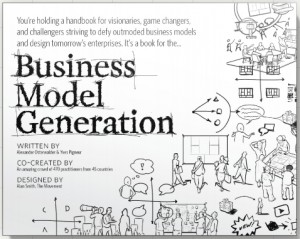The fact is most businesses fail. The simple statistics are that 80% of all new businesses fail in the first 5 years and 80% of the remaining 20% fail in the next 5. At the end of 20 years only 2% are still in business, and few of these would be considered great businesses. Today we see many once great businesses in trouble because they failed to adapt to market changes. The key question is why? And the simple answer is most owners and managers don’t understand the business of business, and what it takes to succeed in good times and bad.
When I was doing restructuring or reorganizing failing businesses and investments, I would repeatedly hear this sad story: “We had a great business idea. We wrote a business plan and raised capital. We started running the business and had success for awhile. Then something happened, we fell apart. Now it’s back to the drawing board.” What I want to talk about is what should be drawn on the board.
Every business has a business model whether it is written down or not. One thing that makes buying a franchise so appealing, and contributes to the survival/success rate being better than non franchise businesses, is the fact that everything is written down. All the franchisee has to do is run the business by the book. While this doesn’t guarantee success, it does help insure consistency of operation. If the market place changes, then the book can be modified. Most business owners that don’t have a written model tell me that when times are good, why bother; and when times are bad, they just don’t have the time or money. They tell me this while we are trying to salvage their their failing business or product.
A business model describes the rationale of how every part of a business functions and  interacts with: every other part of business; with stakeholders, including employees, vendors and investors; and most importantly with consumers. In other words, a business model tells us how we are going to create a world class business that not only makes money, but stays viable in a constantly changing marketplace. That’s why parts of the business model are written in stone (such as the vision and company culture), and parts with erasable markers (markets and distribution).
interacts with: every other part of business; with stakeholders, including employees, vendors and investors; and most importantly with consumers. In other words, a business model tells us how we are going to create a world class business that not only makes money, but stays viable in a constantly changing marketplace. That’s why parts of the business model are written in stone (such as the vision and company culture), and parts with erasable markers (markets and distribution).
Now, to the drawing board to design our business organization that will give us our working model.
The Vision:
To me, the most important thing we can do, and the first thing we should do, is to write the vision for the business and its product or service. This is a biblical principle found in Habakkuk 2:2-3: “And the Lord answered me: “Write the vision; make it plain on tablets, so he may run who reads it. For still the vision awaits its appointed time; it hastens to the end—it will not lie. If it seems slow, wait for it; it will surely come; it will not delay.”
I have found that the lack of a clear and stated vision, or the abdication of the vision by the primary keeper(s) of the vision is the number “1” cause of business failure. The number “2” reason for failure is not having a plan or business model that can actually implement the vision.
Values and Operating Principles:
This creates the “corporate” culture. It tells everyone, every stakeholder in the enterprise, and everyone who comes in contact with the business, just how we conduct our business.
A recent example is Hobby Lobby. The U.S. Supreme Court upheld its right to conduct its business according to its values and operating principles. Everyone knew or should have known the values and operating principles of the owners of Hobby Lobby.
Objectives:
A clear list of our objectives, prioritized, so that the vision can be implemented. All objectives must be measurable and datable (start time, milestones along the way, and completion time) with a system in place to monitor progress and judge results.
Strategies:
A written strategic plan to implement the Objectives of the business and deal with real world situations for today and tomorrow.
Structure:
This includes not only the legal entity or entities necessary to conduct the business, but also how the business is organized internally. The four basic functions of every business are: Management, Operations, Marketing & Finance. Each one needs its own business plan and its own operational and system manuals. In addition it must be determined upfront what type of organizational structure will best manage the business given its needs and culture. This is much more than an organizational chart showing titles, responsibilities and chain-of-command. It describes every function that the business requires done, who will do it, and their how their work be evaluated. It determines whether the structure will be purely hierarchical, a lattice organizational structure with no traditional hierarchy or something in  between.
between.
Often the best structure for a business that requires highly technical or innovative people is a lattice organizational structure. The best example of the lattice organizational structure is W.L. Gore Associates, best known for Gore-tex fabrics and medical products and pharmaceutical processing. I do not necessarily believe that full implementation of Gore’s lattice structure is best, but I’ll let the company’s own description of Gore’s Team-Based, Flat Lattice Organizational Structure speak for itself.
“How we work at Gore sets us apart. Since Bill Gore founded the company in 1958, Gore has been a team-based, flat lattice organization that fosters personal initiative. There are no traditional organizational charts, no chains of command, nor predetermined channels of communication.Instead, we communicate directly with each other and are accountable to fellow members of our multi-disciplined teams.
We encourage hands-on innovation, involving those closest to a project in decision making. Teams organize around opportunities and leaders emerge. This unique kind of corporate structure has proven to be a significant contributor to associate satisfaction and retention. We work hard at maximizing individual potential, maintaining an emphasis on product integrity, and cultivating an environment where creativity can flourish. A fundamental belief in our people and their abilities continues to be the key to our success.
How does all this happen? Associates (not employees) are hired for general work areas. With the guidance of their sponsors (not bosses) and a growing understanding of opportunities and team objectives, associates commit to projects that match their skills. All of  this takes place in an environment that combines freedom with cooperation and autonomy with synergy. Everyone can earn the credibility to define and drive projects. Sponsors help associates chart a course in the organization that will offer personal fulfillment while maximizing their contribution to the enterprise. Leaders may be appointed, but are defined by ‘followership.’ More often, leaders emerge naturally by demonstrating special knowledge, skill, or experience that advances a business objective.”
this takes place in an environment that combines freedom with cooperation and autonomy with synergy. Everyone can earn the credibility to define and drive projects. Sponsors help associates chart a course in the organization that will offer personal fulfillment while maximizing their contribution to the enterprise. Leaders may be appointed, but are defined by ‘followership.’ More often, leaders emerge naturally by demonstrating special knowledge, skill, or experience that advances a business objective.”
Associates at Gore adhere to four basic guiding principles as given by its founder, Bill Gore, who is credited with creating the “lattice organizational structure:
- Fairness to each other and everyone with whom we come in contact
- Freedom to encourage, help, and allow other associates to grow in knowledge, skill, and scope of responsibility
- The ability to make one’s own commitments and keep them
- Consultation with other associates before undertaking actions that could impact the reputation of the company
Product Development:
This is the natural thing that entrepreneurs and businesses do, they work on their product or service. This is their major focus, this is why most businesses fail. Without diminishing the importance of product development, we must understand it has little value if a sustainable business isn’t developed that can successfully deliver the product to the marketplace.
Build the business according to the pattern:
The Lord told Moses to build the tabernacle according to the pattern that he had been shown. I believe the Lord always shows the pattern for the businesses he has created to those that he’s given the vision.
Thanks for reading,
Rick
